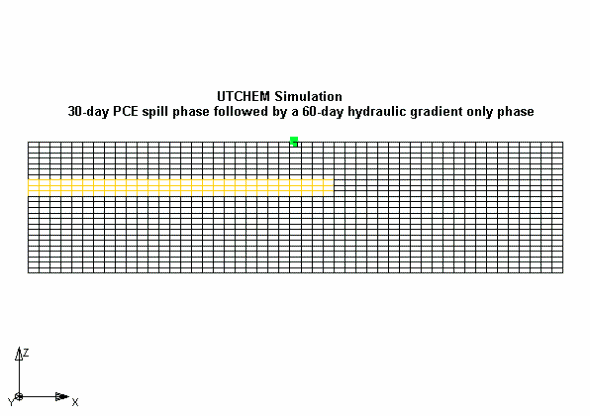GMS:UTCHEM: Difference between revisions
From XMS Wiki
Jump to navigationJump to search
No edit summary |
|||
| Line 16: | Line 16: | ||
UTCHEM is designed for problems with simple geometry and boundary conditions. GMS currently includes no conceptual model for UTCHEM and properties are changed on a cell-by-cell basis. Steps to create a UTCHEM model include: | UTCHEM is designed for problems with simple geometry and boundary conditions. GMS currently includes no conceptual model for UTCHEM and properties are changed on a cell-by-cell basis. Steps to create a UTCHEM model include: | ||
#'''Create a 3D grid''' | #'''Create a 3D grid''' – Before building a UTCHEM simulation, a cell-centered 3D grid must be created which covers the area to be modeled. A grid can be created by selecting the [[GMS:3D Grid Module#Create Grid|'''''Create Grid''''']] command in the '''''Grid''''' menu. A suite of tools and commands for editing grids (inserting rows, changing column widths, etc.) are also provided in the [[GMS:3D Grid Module|3D Grid Module]]. | ||
#'''Define species to be modeled''' | #'''Define species to be modeled''' – The GMS interface to UTCHEM has 8 base species and an unlimited number of additional NAPL phase organic components. Only those components that are checked and included in the Names list will be included in the calculations performed by UTCHEM. GMS does not currently support the Polymer species. The Define Species dialog can be reached by choosing the '''''General Options''''' command from the '''''UTCHEM''''' menu and then selecting the Define Species button. | ||
#'''Define aquifer characteristics''' | #'''Define aquifer characteristics''' – In the Reservoir Properties dialog, you specify aquifer properties. The Porosity, Kx, Pressure, Water Saturation, and Concentration buttons bring up a dialog that allows cell-by-cell editing. | ||
#'''Define species characteristics and interactions''' | #'''Define species characteristics and interactions''' – The dialogs used to edit the properties of, and relations between, species are grouped into the Physical Properties submenu in the UTCHEM menu. They include Phase Behavior, Interfacial Tension, Organic Mass Transfer, Relative Permeability, Viscosity, Component Density, Fluid Compressibility, Capillary Pressure, Diffusion and Dispersion, Adsorption, and Tracer Properties. | ||
#'''Assign boundary conditions''' | #'''Assign boundary conditions''' – UTCHEM is a small scale, local model with simple boundary conditions. Boundary conditions can be set at the left, right or both ends of the model. The other two boundaries and the bottom are no-flow boundaries. The Top Boundary is open check box specifies whether the model domain is confined. When the Vadose Only or Both option is chosen in the Zone to Be Modeled selection group, you must use the Water Table Elevation view windows to specify the boundary between the vadose and the saturated zones. The Pressure at Top Layer view windows allows you to specify a hydraulic gradient. The Concentration of Water, Concentration of Chloride, and Concentration of Calcium view window all specify background concentration values for each boundary. | ||
#'''Insert any wells''' | #'''Insert any wells''' – The UTCHEM interface currently allows four types of vertical wells. They include ''Rate constrained injection well'', ''Pressure constrained injection well'', ''Rate constrained production well'', and ''Pressure constrained production well''. Both Injection well types require you to enter a flow for each phase and a concentration for each species within that phase, whereas the Production Wells only require a single flow or pressure value. Flow and concentration values can only change at the beginning of a new injection period. The number and duration of injection periods can be entered through the Time Options/Injection Periods dialog. Steps for creating a well are as follows: | ||
##Choose the New or Copy button. | ##Choose the '''New''' or '''Copy''' button. | ||
##Specify a name. | ##Specify a name. | ||
##Choose a well type | ##Choose a well type | ||
| Line 30: | Line 30: | ||
##Enter a Skin Factor | ##Enter a Skin Factor | ||
##Enter Phase Flow, Concentrations and Pressure values according to the well Type. | ##Enter Phase Flow, Concentrations and Pressure values according to the well Type. | ||
#'''Save the model''' | #'''Save the model''' – Before running a UTCHEM simulation, the UTCHEM simulation must be saved using the '''Save''' or '''Save As''' commands. GMS saves three files: | ||
## .utc contains the actual UTCHEM input information. This file can be read separately by GMS. | ## .utc contains the actual UTCHEM input information. This file can be read separately by GMS. | ||
## .uts is the UTCHEM super file and is only read by GMS. When you choose the Open command from the File menu, a *.uts file extension is one of the Model Super File filters. | ## .uts is the UTCHEM super file and is only read by GMS. When you choose the Open command from the File menu, a *.uts file extension is one of the Model Super File filters. | ||
